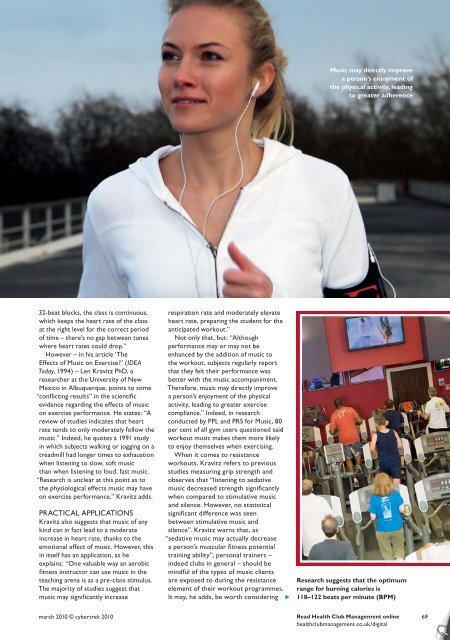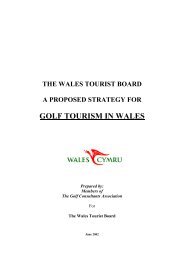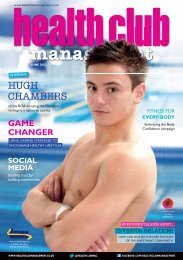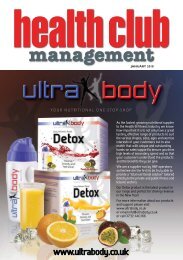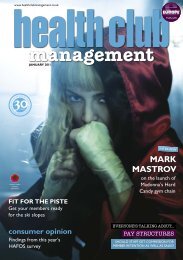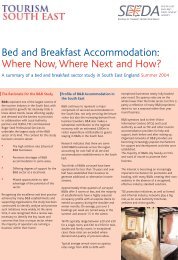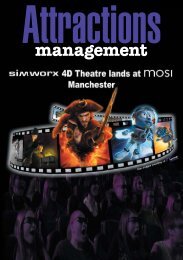Leisure Media HCM March 2010 - TourismInsights
Leisure Media HCM March 2010 - TourismInsights
Leisure Media HCM March 2010 - TourismInsights
You also want an ePaper? Increase the reach of your titles
YUMPU automatically turns print PDFs into web optimized ePapers that Google loves.
Music may directly improve<br />
a person’s enjoyment of<br />
the physical activity, leading<br />
to greater adherence<br />
32-beat blocks, the class is continuous,<br />
which keeps the heart rate of the class<br />
at the right level for the correct period<br />
of time – there’s no gap between tunes<br />
where heart rates could drop.”<br />
However – in his article ‘The<br />
Effects of Music on Exercise?’ (IDEA<br />
Today, 1994) – Len Kravitz PhD, a<br />
researcher at the University of New<br />
Mexico in Albuquerque, points to some<br />
“confl icting results” in the scientifi c<br />
evidence regarding the effects of music<br />
on exercise performance. He states: “A<br />
review of studies indicates that heart<br />
rate tends to only moderately follow the<br />
music.” Indeed, he quotes a 1991 study<br />
in which subjects walking or jogging on a<br />
treadmill had longer times to exhaustion<br />
when listening to slow, soft music<br />
than when listening to loud, fast music.<br />
“Research is unclear at this point as to<br />
the physiological effects music may have<br />
on exercise performance,” Kravitz adds.<br />
PRACTICAL APPLICATIONS<br />
Kravitz also suggests that music of any<br />
kind can in fact lead to a moderate<br />
increase in heart rate, thanks to the<br />
emotional effect of music. However, this<br />
in itself has an application, as he<br />
explains: “One valuable way an aerobic<br />
fitness instructor can use music in the<br />
teaching arena is as a pre-class stimulus.<br />
The majority of studies suggest that<br />
music may significantly increase<br />
respiration rate and moderately elevate<br />
heart rate, preparing the student for the<br />
anticipated workout.”<br />
Not only that, but: “Although<br />
performance may or may not be<br />
enhanced by the addition of music to<br />
the workout, subjects regularly report<br />
that they felt their performance was<br />
better with the music accompaniment.<br />
Therefore, music may directly improve<br />
a person’s enjoyment of the physical<br />
activity, leading to greater exercise<br />
compliance.” Indeed, in research<br />
conducted by PPL and PRS for Music, 80<br />
per cent of all gym users questioned said<br />
workout music makes them more likely<br />
to enjoy themselves when exercising.<br />
When it comes to resistance<br />
workouts, Kravitz refers to previous<br />
studies measuring grip strength and<br />
observes that “listening to sedative<br />
music decreased strength signifi cantly<br />
when compared to stimulative music<br />
and silence. However, no statistical<br />
signifi cant difference was seen<br />
between stimulative music and<br />
silence”. Kravitz warns that, as<br />
“sedative music may actually decrease<br />
a person’s muscular fi tness potential<br />
training ability”, personal trainers –<br />
indeed clubs in general – should be<br />
mindful of the types of music clients<br />
are exposed to during the resistance<br />
element of their workout programmes.<br />
It may, he adds, be worth considering<br />
Research suggests that the optimum<br />
range for burning calories is<br />
118–122 beats per minute (BPM)<br />
march <strong>2010</strong> © cybertrek <strong>2010</strong><br />
Read Health Club Management online<br />
healthclubmanagement.co.uk/digital<br />
69


